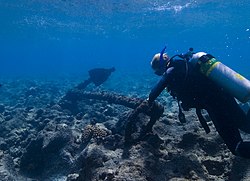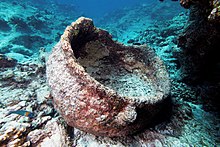
Thomas Gibson Nickerson was an American sailor and author. In 1819, when he was fourteen years old, Nickerson served as cabin boy on the whaleship Essex. On this voyage, the ship was sunk by a whale, and the crew spent three months at sea before the survivors were rescued. In 1876 he wrote The Loss of the Ship "Essex", an account of the ordeal and of his subsequent experiences at sea. The manuscript was lost until 1960, and was first published in 1984.

Kure Atoll or Ocean Island is an atoll in the Pacific Ocean 48 nautical miles west-northwest of Midway Atoll in the Northwestern Hawaiian Islands at 28°25′N178°20′W. A coral ring 6 miles (9.7 km) across encloses a lagoon several meters deep. The atoll's largest island is called Green Island, and is a habitat for hundreds of thousands of seabirds in present day and wildlife staff. A short, unused and unmaintained runway and a portion of one building, both from a former United States Coast Guard LORAN station, are located on the island. Politically, it is part of Hawaii, though nearest island is Midway, which is a separate unorganized territory. Kure Atoll, in addition to being the nesting grounds for tens of thousands of seabirds, has recorded several vagrant terrestrial birds, including snow bunting, eyebrowed thrush, brambling, olive-backed pipit, black kite, Steller's sea eagle and Chinese sparrowhawk. It is currently managed as a Wildlife Bird Sanctuary by the State of Hawaii's Department of Land and Natural Resource–Division of Forestry and Wildlife as one of the co-trustees of Papahānaumokuākea Marine National Monument with support from the Kure Atoll Conservancy. Kure is one of the most westernmost islands of the Northwestern Hawaiian Islands.
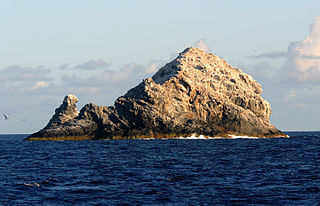
The Gardner Pinnacles are two barren rock outcrops surrounded by a reef and located in the Northwestern Hawaiian Islands.
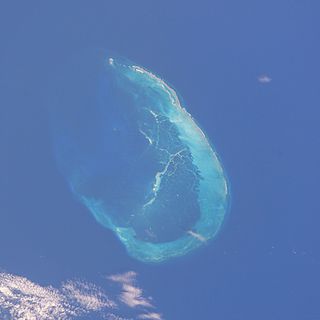
The French Frigate Shoals is the largest atoll in the Northwestern Hawaiian Islands. Its name commemorates French explorer Jean-François de Galaup, comte de Lapérouse, who nearly lost two frigates when attempting to navigate the shoals. It consists of a 20-mile-long (32 km) crescent-shaped reef, twelve sandbars, and the 120-foot-high (37 m) La Perouse Pinnacle, the only remnant of its volcanic origins. The total land area of the islets is 61.508 acres (24.891 ha), while the total coral reef area of the shoals is over 232,000 acres (94,000 ha). Tern Island, with an area of 26.014 acres (10.527 ha), has a landing strip and permanent habitations for a small number of people. It is maintained as a field station in the Hawaiian Islands National Wildlife Refuge by the United States Fish and Wildlife Service. The French Frigate Shoals are about 487 nautical miles northwest of Honolulu. Among the shoals are Tern, which is unique in having an airstrip and is protected by a seawall, and La Perouse Pinnacle, a tall and rocky island in the center of the shoals. The two largest islands after Tern, East and Trig, have mostly washed away, with East being about half the size from storms, but are famed as breeding grounds for turtles. East was also home to Coast Guard base in the late 20th century. The islands are surrounded by a coral reef, and the islands themselves are noted breeding ground for turtles, seals, and birds. Habitation is difficult with little vegetation and no fresh water. The French Frigate Shoals are also called Lalo as part of the marine nature reserve, and along with other islands are visited periodically for research. The highest point in the shoals is on La Perouse Pinnacle, which is a volcanic rock that rises 122 ft (37 m) above the surrounding lagoon.

The Northwestern Hawaiian Islands also known as the Leeward Hawaiian Islands, are a series of islands and atolls located northwest of Kauai and Niʻihau in the Hawaiian island chain. Politically, these islands are part of Honolulu County in the U.S. state of Hawaii, with the exception of Midway Atoll. Midway Atoll is a territory distinct from the State of Hawaii, and is classified as one of the United States Minor Outlying Islands. The United States Census Bureau designates this area, excluding Midway Atoll, as Census Tract 114.98 of Honolulu County. The total land area of these islands is 3.1075 square miles. With the exception of Nihoa, all these islands lie north of the Tropic of Cancer, making them the only islands in Hawaii situated outside the tropics.

The Pearl and Hermes Atoll, also known as Pearl and Hermes Reef, is part of the Northwestern Hawaiian Islands, a group of small islands and atolls that form the farthest northwest portion of the Hawaiian island chain. The atoll consists of a variable number of flat and sandy islets, typically between five and seven. More were noted in historical sources but have since been lost to erosion and rising sea levels.

Essex was an American whaling ship from Nantucket, Massachusetts, which was launched in 1799. On November 20, 1820, while at sea in the southern Pacific Ocean under the command of Captain George Pollard Jr., the ship was attacked and sunk by a sperm whale. About 2,000 nautical miles (3,700 km) from the coast of South America, the 20-man crew was forced to make for land in three whaleboats with what food and water they could salvage from the wreck.

Owen Chase was first mate of the whaler Essex, which sank in the Pacific Ocean on November 20, 1820, after being rammed by a sperm whale. Soon after his return to Nantucket, Chase wrote an account of the shipwreck and the attempts of the crew to reach land in small boats. The book, Narrative of the Most Extraordinary and Distressing Shipwreck of the Whale-Ship Essex, was published in 1821 and would inspire Herman Melville to write Moby-Dick.

In the Heart of the Sea: The Tragedy of the Whaleship Essex is a book by American writer Nathaniel Philbrick about the loss of the whaler Essex in the Pacific Ocean in 1820. The book was published by Viking Press on May 8, 2000, and won the 2000 National Book Award for Nonfiction. It was adapted into a film of the same name, which was released in December 2015.

A whaler or whaling ship is a specialized vessel, designed or adapted for whaling: the catching or processing of whales.
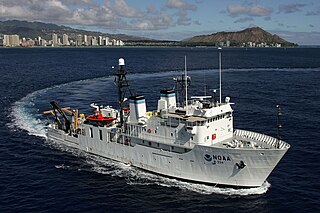
USNS Vindicator (T-AGOS-3) was a United States Navy Stalwart-class modified tactical auxiliary general ocean surveillance ship that was in service from 1984 to 1993. Vindicator then served in the United States Coast Guard from 1994 to 2001 as the medium endurance cutter USCGC Vindicator (WMEC-3). From 2004 to 2020, she was in commission in the National Oceanic and Atmospheric Administration (NOAA) fleet as the oceanographic research ship NOAAS Hiʻialakai.

Some members of the colonial Coffin family were whalers, agents, merchants, and traders who were prominent during the triangular trade in the United States and Canada. Coffin ship owners, captains, masters, and crew men operated triangle and bilateral trade ships out of Nantucket, Massachusetts, US eastern seaports, and Canadian seaports from the 17th to 19th centuries.
The Gardner family were a group of whalers operating out of Nantucket, Massachusetts, from the 17th to 19th centuries. Some members of the family gained wider exposure due to their discovery of various islands in the Pacific Ocean. By marriage, they were related to the Coffins, another Nantucket whaling family.

The whaling disaster of 1871 was an incident off the northern Alaskan coast in which a fleet of 33 American whaling ships were trapped in the Arctic ice in September 1871 and subsequently abandoned. It dealt a serious blow to the American whaling industry, already in decline.

Nantucket shipbuilding began in the late 1700s and culminated in the construction of notable whaling ships during the early 19th century. Shipbuilding was predominantly sited at Brant Point. Whaling ship construction concluded in 1838.

Sperm whaling is the human practice of hunting sperm whales, the largest toothed whale and the deepest-diving marine mammal species, for the oil, meat and bone that can be extracted from the cetaceans' bodies.

La Perouse Pinnacle is a steep basalt outcrop at French Frigate Shoals in the Pacific Ocean. Rising approximately 122 ft (37 m) above sea surface, it is the eroded plug of a shield volcano and caldera that formed 12 million years ago. The rocky formation lies within the Papahānaumokuākea Marine National Monument. Because of its prominence and shape, the pinnacle can be mistaken for a sailing ship from a distance.
Owen Coffin was a sailor aboard the Nantucket whaler Essex when it set sail for the Pacific Ocean on a sperm whale-hunting expedition in August 1819, under the command of his cousin, George Pollard, Jr. In November 1820, a whale rammed and breached the hull of Essex in mid-Pacific, causing Essex to sink. The crew escaped in small whaleboats, with sufficient supplies for two months, but were not rescued within that time. During January 1821, the near-starved survivors began to eat the bodies of those who had died. When even this resource ran out, the four men remaining in Pollard's boat agreed to draw straws to decide which of them should be killed, lest all four die of starvation. Coffin lost in the lottery, and was shot and eaten. The captain volunteered to take Coffin's place but Coffin refused, saying it was his "right" to do so that the others might live.

In the Heart of the Sea is a 2015 historical adventure drama film directed and co-produced by Ron Howard from a screenplay by Charles Leavitt and a story by Leavitt, Rick Jaffa, and Amanda Silver. An international co-production between the United States and Spain, the film stars Chris Hemsworth, Benjamin Walker, Cillian Murphy, Tom Holland, Ben Whishaw, and Brendan Gleeson. It is based on Nathaniel Philbrick's 2000 non-fiction book In the Heart of the Sea: The Tragedy of the Whaleship Essex, about the sinking of the American whaling ship Essex in 1820, an event that in part inspired Herman Melville's 1851 novel Moby-Dick.
George Pollard Jr. was the captain of the whalers Essex and Two Brothers, both of which sank. Following both events, he became a night watchman in his town of Nantucket, Massachusetts. Pollard's life, including his encounter with the sperm whale that sank Essex, likely served as inspiration for Captain Ahab, the whale-obsessed character in Herman Melville's Moby-Dick. Pollard also appears as a character in Melville's Clarel. Various books and films have been created that explain the experiences of Pollard and his crews.
